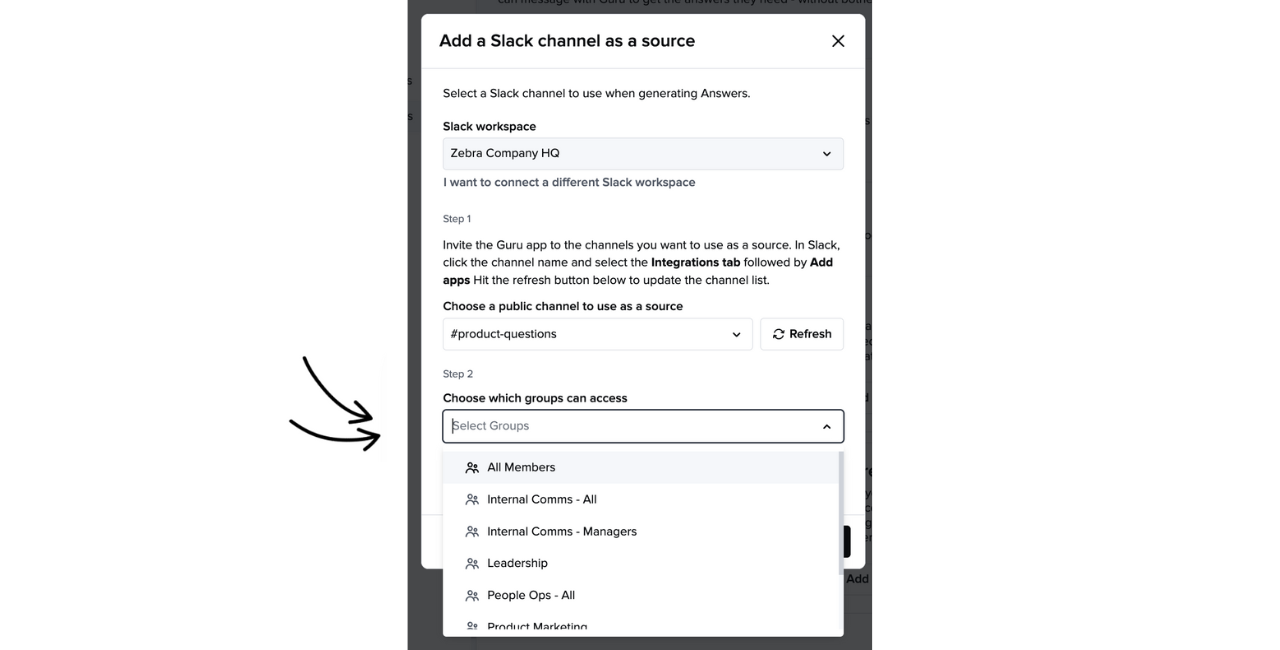Permissioning Knowledge in Guru
Guru lets you assign permissions across Guru content and connected Sources. Admins (or custom roles) control Group and user access to Sources, Knowledge Agents, Collections, and folders.
Access RequiredYou must be a workspace Admin, Creator, or a relevant custom role to create a Collection and assign access to it.
Collection Owners can manage Collections they own.
Best PracticesRunning into permissions or access issues? See Best Practices: Troubleshooting missing or unexpected AI Answers
Giving access to Sources for answers
When an Admin, Creator, or a relevant custom roleconnects sources to Guru, they select which Groups or users can see suggested Answers based on that Source.

To manage access to a Source:
- Click the ellipsis
- Click Manage Access.
- Click the dropdown arrow to edit access settings
- Click Update Access to save changes.
NoteGuru uses a default Knowledge Agent unless additional ones are created. To manage which Groups can use a specific Knowledge Agent, follow the instructions in Creating a Knowledge Agent.
Giving access to Collections
An Admin, Creator, or a relevant custom role can assign each Group or user one of the following roles for a Collection: Collection Owner, Viewer, or custom role.
- Viewer: Can view Cards and add comments.
- Collection Owner: Can manage content and permissions in the Collection.
- Custom Roles depend on how they are configured within Manage > Custom Roles
Learn more about Group roles in Guru
To assign access to a Collection:
- Navigate to Manage > Collections.
- Search for or scroll to the Collection.
- In Search for people or Groups to add, type and select the user or Group name
- Click + Add.
- Click the dropdown arrow next to the Group’s name to set their permission level.
What are the different Group roles applied to Collections?
| Role | Purpose |
|---|---|
| Viewer 📖 | View only access. Can search for and read Cards but cannot edit or manage them. |
| Custom Role ✏️ | Depends on how the role is set up in Manage > Custom Roles |
| Collection Owner ⚙️ | Full content management. For details, see Manage > Custom Roles |
TipIf a user is in multiple Groups with different Collection roles, they will receive the highest level of access.
Removing access to a Collection
To remove a Group or user's access:
- Go to Manage > Collections.
- Locate the user or Group you want to remove and click the dropdown arrow.
- Select Remove Access.
- Confirm your decision by clicking Remove, or click Cancel
NoteIf the removed Group or user was responsible for verifying Cards, Guru will reassign those responsibilities to another Collection Owner.
Folder Permissions
Use folder permissions to give a Group read-only access to specific folders and subfolders—without granting access to the entire Collection.
Access RequiredYou must be a Collection Owner (or a relevant custom role )to create or edit folder permissions.
TipFolder permissions are currently limited to Viewer. You can upvote Folder Level Editing/Authoring Permissions to support feature enhancements.
Applying folder permissions
- Open the Collection and select the folder.
- Click the vertical ellipsis (︙) and select Edit permissions.
- Review current permissions:
- Folder permissions: Groups with direct access.
- Inherited permissions: Groups with access via Collection-level roles.
- In Folder permissions, type or select the Group name.
- Click Add.
Removing access to a folder
- Open the Collection and select the folder.
- Click ︙ > Edit permissions.
- In the modal, find the Group under Folder permissions.
- Click the trash can icon next to the Group name.
- Confirm by clicking Remove Group or Cancel.
Checking folder permissions
All users can view a folder’s permissions by selecting ︙ > View permissions.
Viewing Cards via folder permissions
When a Group has folder-level access:
- The Collection will display a "shared" icon.
- The Group will only see the folders they have access to.
- Subfolders and all Cards within them will also be visible.
- Multiple folders assigned to the same Group will all appear in their Collection view.
Frequently Asked Questions about Permissions
If a Group is given access to a Knowledge Agent, but that Group is not given access to the Sources connected to that Knowledge Agent, will the Knowledge Agent pull responses from those Sources when asked?
No. The Collection or Source will be filtered out of the results if a user does not have access to that Collection/Source.
Want a closer look at some key Guru features and best practices?Check out our events page for demos, workshops, new release roundups, Getting Started bootcamp, guest panelists and more! For upcoming live events and a series of past recordings: Click here to register
Updated 13 days ago
